What is the best type of irrigation? If you ask three different people you may well get three different answers. But I expect a lot of you are wondering about this as you look at your water bills and your yard, so this is what I heard when I did that experiment, along with my own observations. I hope you will share your experiences as well.
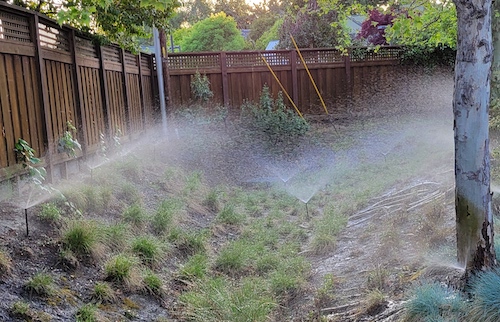
A few spray heads can cover a wide area.
My arborist has been in the business for decades, has a degree in and teaches horticulture, and works closely with a number of landscapers. While he acknowledges that there is no perfect irrigation system, he advocates for spray. It is pretty simple to install since each head covers a large area. It is easy to see if it’s working. And it is the best for most plants since it most closely mimics rain. He is also skeptical about claimed water savings for drip. “The only reason people think that drip saves water is because they don’t run it for long enough!”
He may be speaking for the trees here. During the drought many people neglected to water their trees and we have seen some die-off as a result. Spray irrigation covers a broad area, so trees are likely to benefit from some excess water.
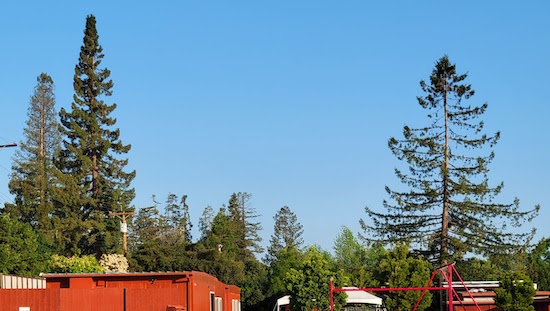
Many redwoods in our area have not been getting enough water and as a result have been thinning out. You can see the difference here between one that is well watered and others that are getting less.
But it's uncommon for people to advocate for spray in our water-stressed area. Most landscapers I talk with recommend “point source” drip irrigation for general landscapes. It can be installed more judiciously -- per plant -- and placed under mulch so that less water evaporates. This can save a significant amount of water since the water goes only where it will be used by the plant.
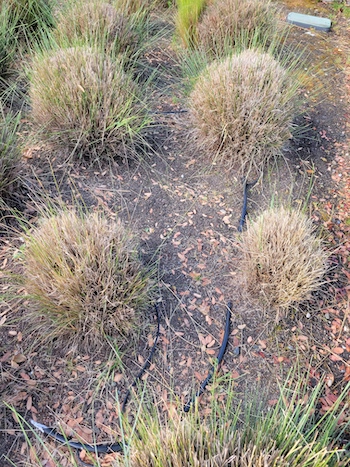
Point source drip tubing watering some grasses.
These systems consist of flexible tubing of different diameters and small emitters that can drip or “bubble” at different rates. There are even “micro spray” emitters for a low-powered spray that can work on small plants.
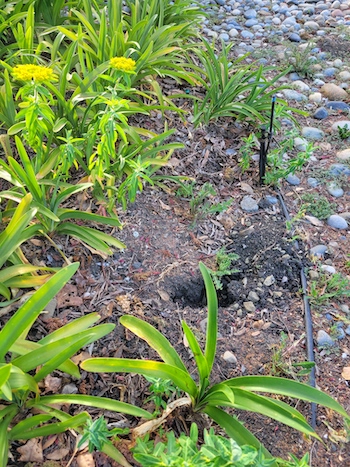
A micro-spray emitter on a drip system can be better for watering ground covers. (I’m not sure how appropriate it is for this particular setting, though.)
The flexible tubing is pretty easy to work with, so while these systems can be finicky to set up, especially if you have many plants, they are easy to adjust. Unlike spray heads, the drip systems do not get impeded as plants grow higher, though emitters and drip lines can get clogged over time. There are pop-up pressure indicators that can help to flag problems.
I think the biggest issue with these systems is their complexity. The drip needs to go once or twice to each plant, then be adjusted as plants grow because you want to water the roots, which are usually around the “canopy” of the plant. In practice the adjustments can be a nuisance and will often be omitted, leading to underwatering of plants and wasting of unused water. It also takes some sophistication to properly irrigate the plants. For example, a tree is better irrigated with a ring of drip tubing rather than with point emitters (as shown below), to encourage even root growth. So these systems are vulnerable to poor design and maintenance.

Two drip emitters are placed on either side of a young tree.
A third option tries to achieve the best of both worlds, the coverage of spray and the water savings of point source drip. It is called inline drip or grid drip irrigation.
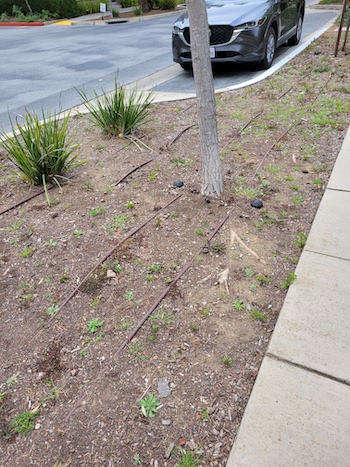
An inline drip system installed along a city street.
The idea behind inline drip is to more uniformly water an area in order to encourage larger and more robust roots. Many landscapers who focus on native plants advocate for this type of irrigation because strong root systems are essential to sustain natives through the dry season. Inline drip is also simpler than point source drip when an area is densely planted.
Each line has regularly spaced emitters (e.g., every 12 or 18 inches), and the lines are spaced evenly apart, ideally with emitters staggered so that the area is evenly watered.

Inline drip systems work best when emitters on adjacent lines are staggered.
The resulting grid creates slow spreading circles of moist soil that expand to cover much of the soil a few inches below the surface.
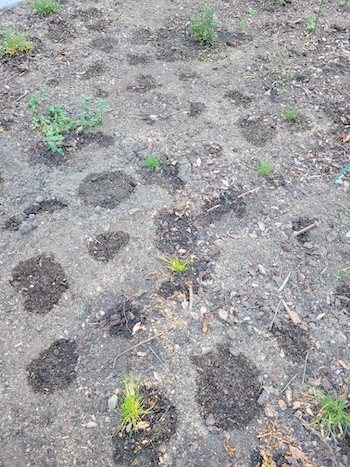
Inline drip systems water more uniformly than point source.
As with point source drip, you need to be careful with trees, particularly certain species like oaks, and box off a drip-free area around them.

Inline drip should not be placed too close to tree trunks.
While inline drip systems do a nice job of saving water while growing good root systems, they tend to be labor-intensive and expensive to install and they require augmented watering (e.g., with a hose or watering can) when plants are young with small root systems. During this period, many emitters will be wasting water since no roots will be nearby. Moreover, inline drip systems, like many point source drip systems, are often visible to passersby when mulch wears off.

These drip lines are not buried and any mulch has blown off.
Some driplines are designed to be buried (e.g., the emitters are strengthened against root intrusion). But then a shovel is more likely to do damage and leaks or clogs will require some excavation to investigate. So this trades off aesthetics for maintenance.
Which of these three types of irrigation is best? An irrigation specialist I spoke with who has installed these for years, both commercial and residential, strongly recommends point source over inline drip for most residential yards. “Grid systems take twice as long to install in these gardens and the material costs twice as much. It’s not worth it.” I tend to agree with him. Unless you have a big, densely planted property, point source irrigation will be easier and cheaper to install and maintain. But you need to be careful to adjust it as your plants grow and get replaced. It won’t “just work” as the garden evolves, as a grid system will. Spray is appealing but in many cases will use more water than drip systems when both are properly installed and managed. (1)
What may matter more than the type of irrigation is what is planted. The best irrigation is no irrigation, and we have some small garden beds in our neighborhood, such as this one, that have been getting by for almost two years with no added irrigation.
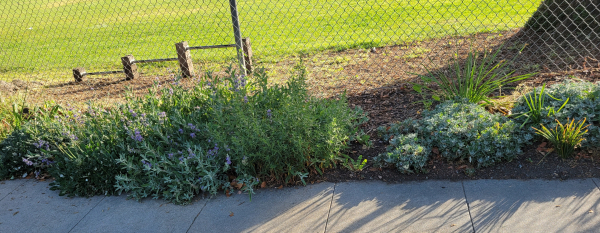
An unirrigated bed of Bee’s Bliss salvia, red buckwheat, California aster, and wooly sunflower, plus some bulbs.
I recently planted natives in an old lawn that I mulched over about two years ago. My gardener expects to water it about every 3 weeks when the plants are mature, which sounds pretty good for my water bill. I talked with a nearby resident with a drip system that got clogged, but he said it didn’t matter because he is easily able to hand water his natives on the rare occasion when they need more than the weather provides. So if you plant the right plants and water them properly when young, you can get by with almost any irrigation, especially after your plants are established.
I’d love to hear your experiences with irrigation. I’ve had all three types in my yard, and while I miss the spray because I could always hear and see when it was working, I don’t miss the uneven application as plants grew and started blocking it. I have some newer inline drip and, after a time-consuming installation, I’m curious to see how it pans out.
Notes and References
1. It is hard to quantify this because it depends on the planting, the type of soil, the watering pattern and time of day, etc. Spray works relatively well for an unmulched shady area (e.g., a ground cover), which will direct most of the water to the ground cover and minimize evaporation. But even then a buried drip system could be as effective while also keeping the surface dry to reduce weeds and evaporation. I find it hard to argue for a spray system on a general garden, which will be at least partly sunny and will have some mulch that will absorb and then evaporate some of the water.
Current Climate Data (March 2023)
Global impacts, US impacts, CO2 metric, Climate dashboard
Comment Guidelines
I hope that your contributions will be an important part of this blog. To keep the discussion productive, please adhere to these guidelines or your comment may be edited or removed.
- Avoid disrespectful, disparaging, snide, angry, or ad hominem comments.
- Stay fact-based and refer to reputable sources.
- Stay on topic.
- In general, maintain this as a welcoming space for all readers.



